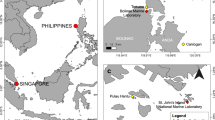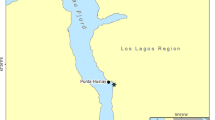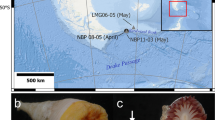Abstract
The reproductive ecology of Tubastraea coccinea Lesson, an azooxanthellate tropical scleractinian coral, was studied over various periods from 1985 to 2006 at four principal eastern Pacific locations in Costa Rica, Panamá, and the Galápagos Islands (Ecuador). This small (polyp diameter 0.8–1.0 cm), relatively cryptic species produced ova and planulae year round, including colonies with as few as 2–10 polyps. Of 424 colonies examined histologically, 13.7% contained both ova and sperm. Mature ova varied in diameter from ∼300 to 800 μm and the time from spawning and fertilization of oocytes to release of brooded planulae was about 6 weeks. Planulae were 0.5–1.5 mm long and they settled and metamorphosed on a variety of substrates after 1–3 days. Spermaries, though more difficult to distinguish in histological sections, were present throughout the year. Spent spermaries were never observed in sections, but several colonies in Panamá and the Galápagos Islands released sperm from night one to night five after full moon, indicating the potential for cross-fertilization among colonies. Planula release was observed at Uva Island (Panamá) in March, May, June, and July, and in general planula presence was higher at warm ocean temperatures at all sites, whether or not the sites were influenced by seasonal upwelling. Annual fecundity estimates for T. coccinea are comparable with other high fecundity brooding species, including the zooxanthellate Porites panamensis, with which it co-occurs in Panamá. Tubastraea coccinea is widely distributed in the tropical Indo-Pacific and has colonized substrates in the western Atlantic. In addition to the reproductive characteristics described in the present study, other features of the biology of T. coccinea, such as an ability to withstand conditions that produce bleaching and mortality in zooxanthellate species, may account for its widespread, low-latitude distribution in multiple oceans.







Similar content being viewed by others
References
Ayre DJ, Resing JM (1986) Sexual and asexual production of planulae in reef corals. Mar Biol 90:187–190
Baird AH, Morse ANC (2004) Induction of metamorphosis in larvae of the brooding corals Acropora palifera and Stylophora pistillata. Mar Freshw Res 55:469–472
Cairns SD (1994) Scleractinia of the temperate North Pacific. Smithson Contrib Zool 557:1–150
Cairns SD (2000) A revision of the shallow-water azooxanthellate Scleractinia of the Western Atlantic. Stud Nat Hist Caribb Reg 75:1–231
Carricart-Ganivet JP, Reyes-Bonilla H (1999) New and previous records of scleractinian corals from Clipperton Atoll, eastern Pacific. Pac Sci 53:370–375
Colley SB, Feingold JS, Peña J, Glynn PW (2000) Reproductive ecology of Diaseris distorta (Michelin) (Fungiidae) in the Galápagos Islands, Ecuador. In: Moosa et al. (eds) Proceedings of 9th international coral reef symposium vol 1. Ministry of Environment, Republic of Indonesia, pp 373–379
Colley SB, Glynn PW, May AS, Maté JL (2006) Species-dependent reproductive responses of eastern Pacific corals to the 1997–1998 ENSO event. In: Proceedings of 10th international coral reef symposium Okinawa, Japan (session 1–2-A), pp 61–70
Cortés J, Jiménez C (2003) Corals and coral reefs of the Pacific coast of Costa Rica: history, research and status. In: Cortés J (ed) Latin American coral reefs. Elsevier, Amsterdam, pp 361–385
Creed JC (2006) Two invasive alien azooxanthellate corals, Tubastraea coccinea and Tubastraea tagusensis, dominate the native zooxanthellate Mussismilia hispida in Brazil. Coral Reefs 25:350
Creed JC, Figueira de Paula A (2007) Substratum preference during recruitment of two invasive alien corals onto shallow-subtidal tropical rocky shores. Mar Ecol Prog Ser 330:101–111
D’Croz L, O’Dea A (2007) Variability in upwelling along the Pacific shelf of Panama and implications for the distribution of nutrients and chlorophyll. Estuar Coast Shelf Sci 73:325–340
Edmondson CH (1946) Behavior of coral planulae under altered saline and thermal conditions. Bernice P Bishop Mus Occ Pap 18:283–304
Fadlallah YH (1983) Sexual reproduction, development and larval biology in scleractinian corals. A review. Coral Reefs 2:129–150
Fenner D (2001) Biogeography of three Caribbean corals (Scleractinia) and the invasion of Tubastraea coccinea into the Gulf of Mexico. Bull Mar Sci 69:1175–1189
Fenner D, Banks K (2004) Orange cup coral Tubastraea coccinea invades Florida and the Flower Garden Banks, northwestern Gulf of Mexico. Coral Reefs 23:505–507
Ferriera CEL, Gocalves JEA, Coutinho R (2004) Ship hulls and oil platforms as potential vectors to marine species introduction. J Coast Res S1:39
Fiedler PC (1992) Seasonal climatologies and variability of eastern tropical Pacific surface waters. National Oceanographic and Atmospheric Administration Tech Rpt Nat Mar Fish Serv 109:1–65
Figueira de Paula AF, Creed JC (2004) Two species of the coral Tubastraea (Cnidaria, Scleractinia) in Brazil: a case of accidental introduction. Bull Mar Sci 74:175–183
Gerrodette T (1981) Dispersal of the solitary coral Balanophyllia elegans by demersal planular larvae. Ecology 62:611–619
Glynn PW (1977) Coral growth in upwelling and nonupwelling areas off the Pacific coast of Panamá. J Mar Res 35:567–585
Glynn PW (1984) Widespread coral mortality and the 1982/83 El Niño warming event. Environ Conserv 11:133–146
Glynn PW (1990) Coral mortality and disturbances to coral reefs in the tropical eastern Pacific. In: Glynn PW (ed) Global ecological consequences of the 1982–1983 El Niño-Southern Oscillation. Elsevier, Amsterdam, pp 55–126. Elsevier Oceanogr Ser No. 52
Glynn PW (2003) Coral communities and coral reefs of Ecuador. In: Cortés J (ed) Latin American coral reefs. Elsevier, Amsterdam, pp 449–472
Glynn PW, Ault JS (2000) A biogeographic analysis and review of the far eastern Pacific coral reef region. Coral Reefs 19:1–23
Glynn PW, Wellington GM (1983) Corals and coral reefs of the Galápagos Islands. University of California Press, Berkeley, pp 330
Glynn PW, Colgan MW (1992) Sporadic disturbances in fluctuating coral reef environments: El Niño and coral reef development in the eastern Pacific. Am Zool 32:707–718
Glynn PW, Gassman NJ, Eakin CM, Cortés J, Smith DB, Guzmán HM (1991) Reef coral reproduction in the eastern Pacific: Costa Rica, Panamá, and Galápagos Islands (Ecuador). I. Pocilloporidae. Mar Biol 109:355–368
Glynn PW, Colley SB, Eakin CM, Smith DB, Cortés J, Gassman NJ, Guzmán HM, Del Rosario JB, Feingold JS (1994) Reef coral reproduction in the eastern Pacific: Costa Rica, Panamá, and Galápagos Islands (Ecuador). II. Poritidae. Mar Biol 118:191–208
Glynn PW, Colley SB, Gassman NJ, Black K, Cortés J, Maté JL (1996a) Reef coral reproduction in the eastern Pacific: Costa Rica, Panamá and Galápagos Islands (Ecuador). III. Agariciidae (Pavona gigantea and Gardineroseris planulata). Mar Biol 125:579–601
Glynn PW, Veron JEN, Wellington GM (1996b) Clipperton Atoll (eastern Pacific): oceanography, geomorphology, reef-building coral ecology and biogeography. Coral Reefs 15:71–99
Glynn PW, Colley SB, Ting JH, Maté JL, Guzmán HM (2000) Reef coral reproduction in the eastern Pacific: Costa Rica, Panamá and Galápagos Islands (Ecuador). IV. Agariciidae, recruitment and recovery of Pavona varians and Pavona sp. a. Mar Biol 136:785–805
Glynn PW, Maté JL, Baker AC, Calderón MO (2001) Coral bleaching and mortality in Panamá and Ecuador during the 1997–1998 El Niño-Southern Oscillation event: spatial/temporal patterns and comparisons with the 1982–1983 event. Bull Mar Sci 69:79–109
Guest JR, Baird AH, Goh BPL, Chou LM (2005) Seasonal reproduction in equatorial reef corals. Invertebr Reprod Dev 48:207–218
Guzmán HM, Cortés J (1989) Growth rates of eight species of scleractinian corals in the eastern Pacific (Costa Rica). Bull Mar Sci 44:1186–1194
Guzmán HM, Cortés J (1992) Cocos Island (Pacific of Costa Rica) coral reefs after the 1982–83 El Niño disturbance. Rev Biol Trop 40:309–324
Guzman HM, Guevara CA, Breedy O (2004) Distribution, diversity, and conservation of coral reefs and coral communities in the largest marine protected area of Pacific Panama (Coiba Island). Environ Conserv 31:111–121
Hall VR, Hughes TP (1996) Reproductive strategies of modular organisms: comparative studies of reef-building corals. Ecology 77:950–963
Harris JW, Stocker H (1998) Handbook of mathematics and computational science. Springer, New York
Harrison PL, Wallace CC (1990) Reproduction, dispersal and recruitment of scleractinian corals. In: Dubinsky Z (ed) Coral reefs, ecosystems of the world 25. Elsevier, Amsterdam, pp. 133–207
Harriott VJ (1983) Reproductive ecology of four scleractinian species at Lizard Island, Great Barrier Reef. Coral Reefs 2:9–18
Hayashibara T, Shimoike K, Kimura T, Hosaka S, Heyward A, Harrison P, Kudo K, Omori M (1993) Patterns of coral spawning at Akajima Island, Okinawa, Japan. Mar Ecol Prog Ser 101:253–262
Jokiel PL (1985) Lunar periodicity of planula release in the reef coral Pocillopora damicornis in relation to various environmental factors, vol 4. In: Proceedings of the 5th international coral reef congress, Tahiti, pp 307–312
Koh EGL, Sweatman H (2000) Chemical warfare among scleractinians: bioactive natural products from Tubastraea faulkneri Wells kill larvae of potential competitors. J Exp Mar Biol Ecol 251:141–160
Kwiecinski B, Chial ZB (1983) Algunos aspectos de la oceanografía del Golfo de Chiriquí, su comparación con el Golfo de Panamá. Rev Biol Trop 31:323–325
Lin K (2005) Timing of larval release by five coral species in southern Taiwan: seasonality, lunar and diurnal periodicity. Master’s thesis, 69 p, National Sun Yat-Sen University, Taiwan
Loya Y (1976) The Red Sea coral Stylophora pistillata is an r-strategist. Nature 259:478–480
Maragos JE (1977) Order Scleractinia: stony corals. In: Devaney DM, Eldredge LG (eds) Reef and shore fauna of Hawaii, Section 1: Protozoa through Ctenophora. Bernice P. Bishop Museum Special Pub 64(1). Bishop Mus Press, Honolulu, pp 158–241
Marshall AT (1996) Calcification in hermatypic and ahermatypic corals. Science 271 5249:637–639
Maté JL (2003) Corals and coral reefs of the Pacific coast of Panamá. In: Cortés J (ed) Latin American coral reefs, Elsevier, Amsterdam, pp 387–417
Mendes JM, Woodley JD (2002) Timing of reproduction in Montastrea annularis: relationship to environmental variables. Mar Ecol Prog Ser 227:241–251
Penland L, Kloulechad J, Idip D, van Woesik R (2004) Coral spawning in the western Pacific Ocean is related to solar insolation: evidence of multiple spawning events in Palau. Coral Reefs 23:133–140
Podestá GP, Glynn PW (1997) Sea surface temperature variability in Panamá and Galápagos: extreme temperatures causing coral bleaching. J Geophys Res 102(C7):15,749–15,759
Prahl H von (1985) Blanqueo masivo y muerte de corales hermatípicos en el Pacífico Colombiano atribuidos al fenómeno de El Niño 1982–83. Bol Erfen 12:22–24
Reyes Bonilla H (2002) Checklist of valid names and synonyms of stony corals (Anthozoa: Scleractinia) from the eastern Pacific. J Nat Hist 36:1–13
Reyes Bonilla H, Barraza JE (2003) Corals and associated marine communities from El Salvador. In: Cortés J (ed) Latin American coral reefs, Elsevier, Amsterdam, pp 351–360
Reyes Bonilla H, Perez Vivar TL, Ketchum JT (1997) Nuevos registros del coral ahermatípico Tubastraea coccinea Lesson, 1829 (Scleractinia: Dendrophylliidae) en el Pacífico de México. Rev Invest Cient Univ Auton Baja Calif Sur (Ser Cienc Mar) 8:31–33
Richmond RH (1997) Reproduction and recruitment in corals: critical links in the persistence of reefs. In: Birkeland C (ed) Life and death of coral reefs. Chapman & Hall, New York, pp 175–197
Richmond RH, Hunter CL (1990) Reproduction and recruitment of corals: comparisons among the Caribbean, the tropical Pacific, and the Red Sea. Mar Ecol Prog Ser 60:185–203
Robinson G (1985) Influence of the 1982–83 El Niño on Galápagos marine life. In: Robinson G, del Pino EM (eds) El Niño en las Islas Galápagos: el evento de 1982–1983. Publication of the Charles Darwin Foundation for the Galápagos Islands, Quito, pp 153–190
Smith DB (1991) The reproduction and recruitment in Porites panamensis Verrill at Uva Island, Pacific Panama. MS thesis, Univ Miami, 64 p
Van Moorsel GWNM (1988) Early maximum growth of stony corals (Scleractinia) after settlement on artificial substrata on a Caribbean reef. Mar Ecol Prog Ser 50:127–135
Veron JEN (2000) Corals of the world vol 3. Australian Institute of Marine Science. Townsville, 490 p
Wells JW (1983) Annotated list of the scleractinian corals of the Galápagos Islands. In: Glynn PW, Wellington GM (eds) Corals and coral reefs of the Galápagos Islands. University of California Press, Berkeley, pp 212–295
Willis BL, Babcock RC, Harrison PL, Oliver JK (1985) Patterns in the mass spawning of corals on The Great Barrier Reef from 1981 to 1984, vol 4. In: Proceedings of the 5th international coral reef congress, Tahiti, pp 343–348
Acknowledgments
Help with collections, field observations and laboratory work was kindly offered by O. Barrio, M. Basile, K. Black, L. D’Croz, J. B. del Rosario, C. M. Eakin, J. Firman, J. Jara, S. Man, P. Martínez, F. Rivera, J. Sabater, D. Smith, A. Velarde, D. Holstein, and A. Romanski. C. Langdon offered helpful advice with statistical analyses. The following host-country institutions greatly facilitated this research: Costa Rica, Centro de Investigaciones en Ciencias del Mar y Limnología, Universidad de Costa Rica and Sistema Nacional de Áreas de Conservación, Ministerio del Ambiente; Panamá, Departamento de Biología Acuática, Instituto Nacional de Recursos Naturales Renovables (INRENARE), and Smithsonian Tropical Research Institute; Ecuador, Charles Darwin Research Station, and the Galápagos National Park Service. Research funding was provided largely by the U. S. National Science Foundation (grant OCE-0526361 and earlier awards), the Darwin Initiative, Conservation International, and the National Geographic Society. This is a contribution from the University of Miami, Rosenstiel School of Marine and Atmospheric Science.
Author information
Authors and Affiliations
Corresponding author
Additional information
Communicated by J.P. Grassle.
An erratum to this article can be found at http://dx.doi.org/10.1007/s00227-008-0926-y
Electronic supplementary material
Below is the link to the electronic supplementary material.
Rights and permissions
About this article
Cite this article
Glynn, P.W., Colley, S.B., Maté, J.L. et al. Reproductive ecology of the azooxanthellate coral Tubastraea coccinea in the Equatorial Eastern Pacific: Part V. Dendrophylliidae. Mar Biol 153, 529–544 (2008). https://doi.org/10.1007/s00227-007-0827-5
Received:
Accepted:
Published:
Issue Date:
DOI: https://doi.org/10.1007/s00227-007-0827-5




